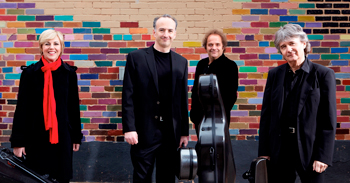by Daniel Hathaway

Violinists Edward Dusinberre and Károly Schranz, violist Geraldine Walther and cellist András Fejér gave the Cleveland Chamber Music Society a pair of electrifying evenings with the six Bartók quartets on March 17 and 18 at Plymouth Church in Shaker Heights. Then, after concerts in Boston, Berkeley, Richmond, Charlottesville and Philadelphia, they returned to the area on April 13 to conclude this season’s Oberlin Artist Recital Series with a no-less riveting program of works by Shostakovich, Webern and Beethoven in Finney Chapel.
The Takács are a classy quartet who bring a fine sense of style and deep levels of absorption to everything they play. Nowhere was this so clear on Sunday’s recital than in Anton Webern’s Six Bagatelles, op. 9 and Five Movements, op. 5. The tiny bagatelles are something like musical haiku that capture an evanescent moment. Operating on a simplified twelve-tone system, but one that essentially uses all twelve tones without development (inversion, retrograde, retrograde inversion), the bagatelles are models of economy. The Five Pieces are more involved, but not much longer, lasting eleven minutes in toto.
A quotation from Malcolm Hayes’s book on Webern in Peter Laki’s program notes describes the ethos of the Five Movements perfectly in their “all-too-vivid evocation of the dispiriting side of life in turn-of-the-century Vienna. This is the music of bare, fusty, unheated rooms; of pale street-lamps in cold, bitterly windswept streets; of the hideously black sense of inner emptiness and isolation the artist, like anyone else, periodically has to endure.”
All of the Webern the Takács played had elements of that psychological bleakness — often expressed through threadbare textures. But the quartet presented all eleven works as tiny, encapsulated masterpieces, completely involving themselves in each one before moving on. Strange wind sounds from outside added a special ambiance.
Edwin Dusenberre noted from the stage that Beethoven’s op. 132 was planned to go with the Webern as an earlier example of stylistic innovation. (And speaking of doing new things, the piece was first played in a Vienna tavern, so there’s nothing much new under the twenty-first century sun!)
The quartet serves up a continuous succession of surprises on either side of the famous “Holy Song of Thanksgiving,” a luminous episode played with stark purity by the Takács, who were completely in sync with one another even in matters of adding, subtracting and matching each other’s vibrato.
The concert began with Shostakovich’s second quartet, written in 1944 in the course of an intense week at Ivanovo, the Soviet Composers’ Union retreat. A folksy tune becomes the subject for tightly motivic development in the first movement. An initially sweet and poignant violin solo leads to a climax of dramatic intensity in the second. An eerie waltz features a cello solo against muted strings in the third, and a theme with variations introduced by the viola provides the formal framework for the eventful finale. Dramatic but not sardonic as Shostakovich’s later works became, the piece was a fine opener, showing the Takács’s prowess both as individuals and expert ensemble players.
Before the performance, recently-appointed conservatory Dean Andrea Kalyn announced next season’s lineup, which includes The Calder Quartet (in residence at Oberlin through 2016), pianist Garrick Ohlsson, the St. Lawrence Quartet, the Bang on a Can All-Stars, bass-baritone John Relyea, and two Oberlin alums, violinist Jennifer Koh ’97, violin, and pianist Jeremy Denk ’90. Denk will appear with The Cleveland Orchestra, Susanna Mälkki, conducting.
Published on ClevelandClassical.com April 23, 2014.
Click here for a printable copy of this article.



